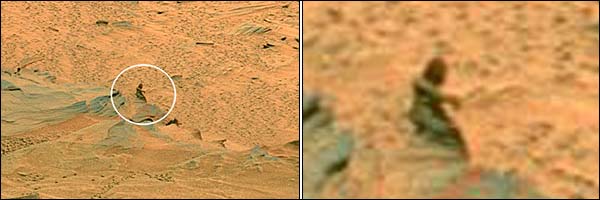"I was walking on Mars one day, in the merry merry month of May..."

Posted on 09/20/2018 2:03:35 PM PDT by ETL
There are plenty of challenges to putting people on Mars, whether you look at the rocket, the astronaut or the planet itself.
New data from one of the many spacecraft at work around Mars confirm just how dangerous a round-trip human journey would be by measuring the amount of radiation an astronaut would experience.
Cosmic radiation is made up of incredibly tiny particles moving incredibly fast, nearly at the speed of light — the sort of phenomenon a human body isn't very well equipped to withstand. That radiation travels across all of space, but Earth's atmosphere buffers us from the worst of its impacts. That means the farther away from Earth's surface you go, the more cosmic radiation your body absorbs.
[Space Radiation Threat to Astronauts Explained (Infographic)]
By the time you're traveling to and from Mars, that gets to be a very big problem. "Radiation doses accumulated by astronauts in interplanetary space would be several hundred times larger than the doses accumulated by humans over the same time period on Earth, and several times larger than the doses of astronauts and cosmonauts working on the International Space Station," Jordanka Semkova, a physicist at the Bulgarian Academy of Sciences and lead scientist on the new research, said in a statement. "Our results show that the journey itself would provide very significant exposure for the astronauts to radiation."
Those results are based on data from the European Space Agency's Trace Gas Orbiter, a spacecraft that has been circling the Red Planet since 2016. One of the instruments it carries is a dosimeter, which has been taking measurements throughout the orbiter's journey.
According to the team behind the new research, those measurements show that just getting to and from Mars would expose astronauts to at least 60 percent of the current recommended maximum career exposure.
What precisely that recommended maximum is varies with sex and age, but it ranges from 1 sievert for a 25-year-old woman to 4 sieverts for a 55-year-old man. (The measurement of sieverts already accounts for differences in weight.)
But 60 percent just for the round-trip is particularly concerning, since presumably the point of going to Mars is to spend at least a little time on the planet's surface — ideally, without overdosing on radiation.

Well ship ‘em up there in a lead box...

Bigfoot on Mars!
And that picture’s from?..
Total Recall. The triple breasted whore.
Nice!
Nice!
Magic Underwear?................
There was a certain manga I read where it will take generations to adapt to space.
Those born in space (mars, other planets) will adapt to non-earth conditions so it will be easier for them to travel. Those of earth will have a harder time to adjust. In addition, in this manga series, they had to clone humans who can easily adapt to space radiation like it was a normal thing.
A spacecraft surrounded by a bladder of H2O. Water is needed anyway and it is amazing at zeroing radiation.
So after the water is used as a radiation shield, are you saying its safe to drink?
I think the magnetosphere shields life for cosmic rays. Should it be disrupted we’ll fry like bacon.
Magnetosphere
Earth’s magnetic field, predominantly dipolar at its surface, is distorted further out by the solar wind. This is a stream of charged particles leaving the Sun’s corona and accelerating to a speed of 200 to 1000 kilometres per second. They carry with them a magnetic field, the interplanetary magnetic field (IMF).[24]
The solar wind exerts a pressure, and if it could reach Earth’s atmosphere it would erode it. However, it is kept away by the pressure of the Earth’s magnetic field. The magnetopause, the area where the pressures balance, is the boundary of the magnetosphere.
Despite its name, the magnetosphere is asymmetric, with the sunward side being about 10 Earth radii out but the other side stretching out in a magnetotail that extends beyond 200 Earth radii.[25] Sunward of the magnetopause is the bow shock, the area where the solar wind slows abruptly.[24]
Inside the magnetosphere is the plasmasphere, a donut-shaped region containing low-energy charged particles, or plasma. This region begins at a height of 60 km, extends up to 3 or 4 Earth radii, and includes the ionosphere. This region rotates with the Earth.[25]
There are also two concentric tire-shaped regions, called the Van Allen radiation belts, with high-energy ions (energies from 0.1 to 10 million electron volts (MeV)).
The inner belt is 1–2 Earth radii out while the outer belt is at 4–7 Earth radii. The plasmasphere and Van Allen belts have partial overlap, with the extent of overlap varying greatly with solar activity.[26]
As well as deflecting the solar wind, the Earth’s magnetic field deflects cosmic rays, high-energy charged particles that are mostly from outside the Solar system. (Many cosmic rays are kept out of the Solar system by the Sun’s magnetosphere, or heliosphere.[27])
By contrast, astronauts on the Moon risk exposure to radiation. Anyone who had been on the Moon’s surface during a particularly violent solar eruption in 2005 would have received a lethal dose.[24]
Some of the charged particles do get into the magnetosphere. These spiral around field lines, bouncing back and forth between the poles several times per second. In addition, positive ions slowly drift westward and negative ions drift eastward, giving rise to a ring current.
This current reduces the magnetic field at the Earth’s surface.[24] Particles that penetrate the ionosphere and collide with the atoms there give rise to the lights of the aurorae and also emit X-rays.[25]
The varying conditions in the magnetosphere, known as space weather, are largely driven by solar activity. If the solar wind is weak, the magnetosphere expands; while if it is strong, it compresses the magnetosphere and more of it gets in. Periods of particularly intense activity, called geomagnetic storms, can occur when a coronal mass ejection erupts above the Sun and sends a shock wave through the Solar System.
Such a wave can take just two days to reach the Earth. Geomagnetic storms can cause a lot of disruption; the “Halloween” storm of 2003 damaged more than a third of NASA’s satellites. The largest documented storm occurred in 1859. It induced currents strong enough to short out telegraph lines, and aurorae were reported as far south as Hawaii.[24][28]
https://en.wikipedia.org/wiki/Earth%27s_magnetic_field#Magnetosphere
Can we send a spacebus filled with the Democrat Congress.
Made of plastic.
No loss to us.
And we get rid of lots of vermin.
What’s a few less electrons?
People with thick skins need not worry.
So, let’s send just liberals to Mars. And keep them there, permanently.

On a visit to the NASA Jet Propulsion Laboratory in 2005, Jackson Lee made embarrassing news by asking if the Mars Pathfinder had taken an image of the flag planted there in 1969 by Neil Armstrong.[2]
Prior to the 110th Congress, Jackson Lee served on the House Science Committee and on the Subcommittee that oversees space policy and NASA.
http://web.archive.org/web/20100409095818/http://en.wikipedia.org/wiki/Sheila_Jackson_Lee

[pp] "Did the Mars Pathfinder take an image of the flag planted there in 1969 by Neil Armstrong?"



Disclaimer: Opinions posted on Free Republic are those of the individual posters and do not necessarily represent the opinion of Free Republic or its management. All materials posted herein are protected by copyright law and the exemption for fair use of copyrighted works.